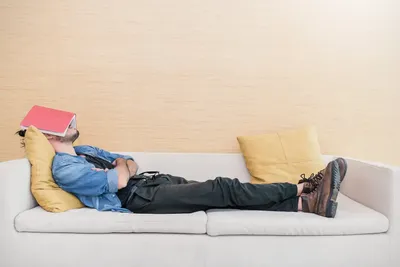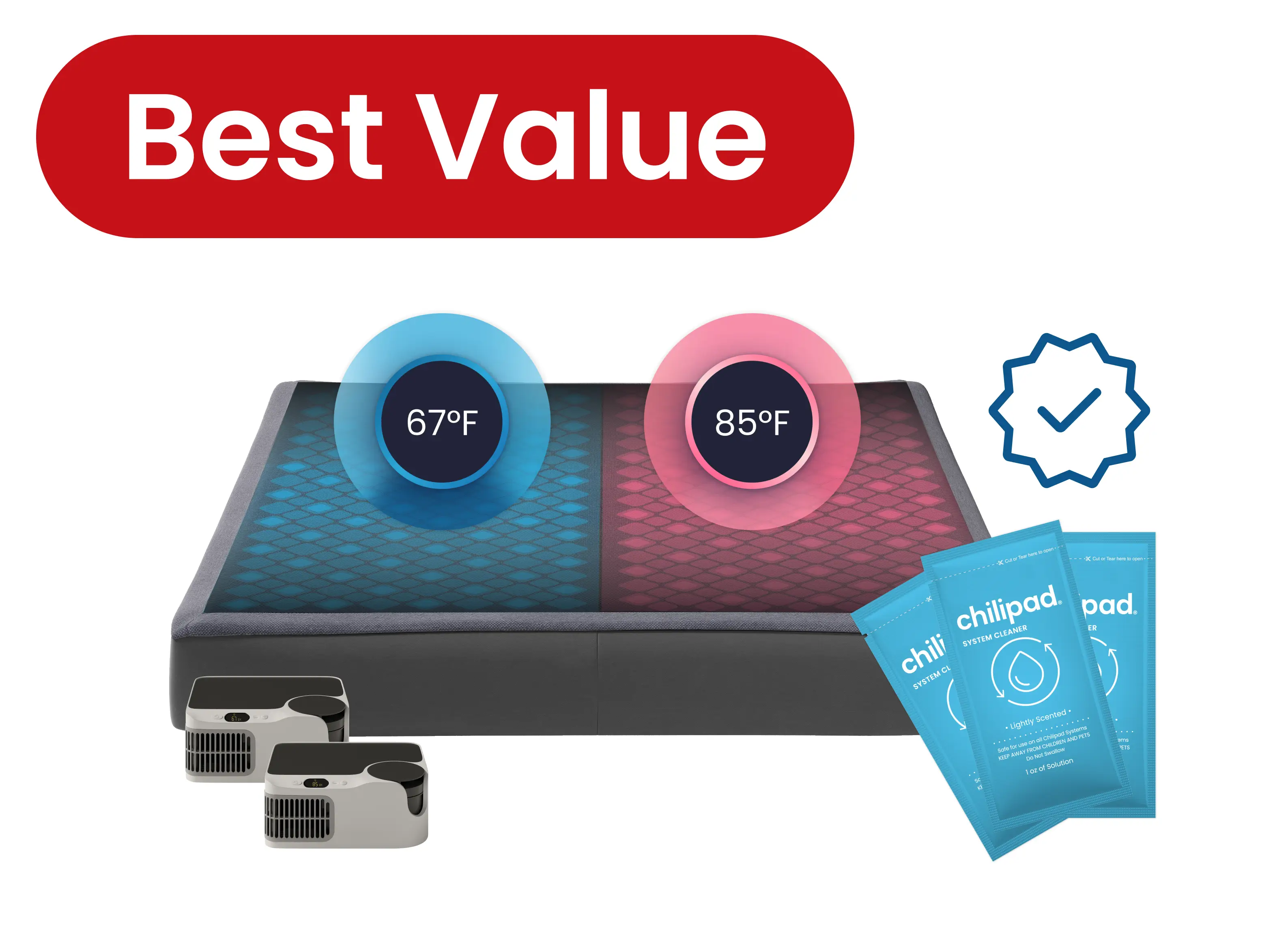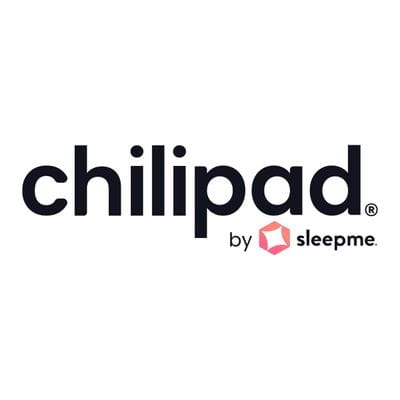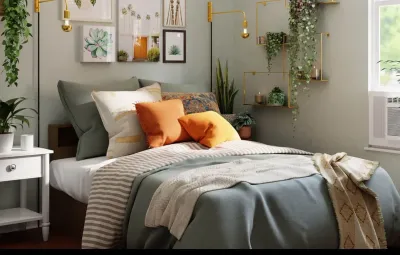
Key Takeaways
The ideal nap length depends on your goal, but short, well-timed naps can boost energy and focus without disrupting nighttime sleep.
- A 10 to 20 minute power nap can improve alertness, focus, and mood without causing grogginess.
- A 90 minute nap allows your brain to complete a full sleep cycle, which can support memory, creativity, and emotional balance.
- Naps lasting 30 to 60 minutes often lead to sleep inertia, making it harder to wake up feeling refreshed.
- Napping too late in the day can interfere with your ability to fall asleep at night, so earlier afternoon naps are best.
- Everyone responds differently to naps, so tracking how different nap lengths affect your energy can help you find your personal sweet spot.
Have you ever taken a 15-minute power nap right before a class or an important test? Or maybe you've caught some serious midday shut-eye at work after a big lunch. But how long you should nap can make a big difference. Sometimes, you might have slept for 30 minutes or an hour, while other times, you might have slept the entire day away.
And there might have been times when you've grabbed a quick catnap just to feel better.
We've all been there at some point in our lives.
The benefits of napping vary greatly. However, some nap lengths are more conducive to fatigue recovery and enhanced cognitive function, while others can worsen sleepiness.
Taking a nap at the right time can help you combat the unpleasant symptoms of fatigue, such as sleepiness and difficulty concentrating. However, how long should you nap for?
Did You Know: Taking a short nap during the day can improve your performance at work. [1]
Benefits of Napping: How Long Should You Nap for Optimal Rest?
Napping isn't just about catching up on lost sleep; it's a practice that benefits your mental and physical well-being. From enhancing cognitive function to an energy boost boosting mood, the advantages of a brief shuteye are numerous and varied.
Discover how these short rest periods can significantly improve your health and daily life. Learn more by reading our blog, which discusses everything you need to know about napping and the benefits of napping in everyday life.
Save Up to 15%! Enhance Your Nap with the Chilipad
Pair your nap with our cooling mattress topper to unlock the power of truly revitalizing sleep. Set your current mattress anywhere from 55°F to 115°F, whether you’re settling in for the night or taking a quick nap.
Drawbacks of Napping
While there are plenty of nap benefits, it also comes with some drawbacks. Naps, significantly longer ones, can lead to sleep inertia, a state of grogginess and disorientation that might follow waking up.
This can temporarily impair cognitive function and reaction time. Moreover, napping late in the day or for extended periods can interfere with your nighttime sleep pattern, making it harder to fall or stay asleep at night. This disruption can lead to a cycle of poor sleep habits and overall sleep quality.
To better understand sleep inertia and its symptoms, explore our detailed page here: Understanding Sleep Inertia: Symptoms and Effects.
Sleep Study: An analysis of multiple studies suggests that napping for more than 60 minutes a day may increase the risk of developing type 2 diabetes. [2]
Best Nap Lengths for Maximum Sleep
In the United States, insufficient sleep is widespread, affecting about one-third of adults and 73% of high school students. [3] This sleep deficit not only heightens the risk of vehicle accidents and workplace mishaps but also poses significant health risks. Therefore, providing adequate sleep, both in quality and quantity, is crucial for overall safety and health.
The key to finding the sweet spot for napping is understanding the length of sleep cycles. A full cycle lasts between 90 and 110 minutes, during which your body goes through all four stages of sleep: wake, light sleep, deep sleep, and REM sleep. [4] When you sleep at night, these sleep stages repeat several times, giving your body and brain time to recharge.
When you nap, you don't always benefit from a full sleep cycle because entering into a deep sleep and REM sleep can make waking up difficult, putting you at risk of feeling drowsy. If you want to know how long you should nap to feel energized, we have provided two nap lengths that adults should stick to:
The Science Behind the Perfect Nap Length
Naps are more than just a midday break; they're a scientifically proven way to boost cognitive function, improve mood, and enhance overall well-being. But not all naps are created equal. The length of your nap can significantly impact its effectiveness.
Did You Know: Sleep pods offer a quiet, comfortable space designed to help you take the perfect nap—whether it’s a quick 20-minute power nap or a full 90-minute sleep cycle—maximizing rest and recovery.
The Science of Sleep Cycles
Our sleep is divided into cycles, each lasting approximately 90 minutes. These cycles consist of two main stages:
- REM (Rapid Eye Movement) sleep: This stage is associated with dreams and memory consolidation.
- Non-REM sleep: This stage is divided into four stages, with stage 3 being the deepest.
Aim for certain stages of sleep to get the most out of a nap. If you want to know how long you should nap to feel energized, we have provided two nap lengths that adults should stick to below.
What is the 30-90 rule for taking a nap?
The 30-90 rule for napping recommends either taking a nap for less than 30 minutes or going for a full 90 minutes. This guideline is based on the idea that shorter naps can help prevent grogginess, while longer naps allow for a complete sleep cycle, making you feel more refreshed.
Napping for Less Than 30 Minutes:
A nap of 10-20 minutes can give you a quick burst of energy and alertness without entering deep sleep, which helps you wake up feeling refreshed and ready to go.
Napping for 90 Minutes:
A 90-minute nap allows you to complete a full sleep cycle, including light sleep, deep sleep, and REM sleep. This type of nap can improve memory, creativity, and overall mental clarity.
Napping between 30 and 90 minutes can cause sleep inertia, which is that groggy, disoriented feeling you get when waking up from restorative sleep. By sticking to the 30-90 rule, you can avoid this grogginess and maximize the benefits of your nap.
Did You Know: Throughout a complete night's sleep, an individual will experience multiple complete cycles. Generally, the entire sleep cycle lasts approximately 90 to 110 minutes for most people. [5]
Exploring the Different Nap Lengths
Everyone recharges differently. Some can power through the day without a nap, while others need a few minutes of rest, and still others may need longer breaks to feel refreshed. A lot of this comes down to what your body naturally needs.
The trick is figuring out which nap length works best for you. Short naps can give a quick energy boost, while longer ones dive deeper into rest and recovery. To help you understand the differences, we've broken down the different popular nap durations, their benefits, and how to choose the one that best fits your lifestyle and health goals.
5 - 10 Minutes: Micro Naps
A nap this short is often called a “micro nap.” It provides enough time for your brain to get a quick reset. Yes, even five to ten minutes can leave you feeling sharper and more alert, and the best part is you skip that groggy feeling that comes with longer naps.
Micro naps are especially useful when time is limited, but a quick recharge is needed. A study examined the effects of different nap lengths (5, 10, 20 and 30 minutes). Results showed that a 10-minute nap resulted in the greatest increase in immediate alertness. [6]
This length is ideal for busy professionals, High School or College students, and parents who might not have much time but need a quick recharge to stay focused and productive.
20 Minutes: Coffee Naps
Yes, there is such a thing. You take a nap immediately after drinking a cup of coffee. Doing so sounds very odd, but the caffeine in the coffee will take approximately 20 minutes to kick in, which is about the length of a standard short nap.
When you wake up, you'll have both the benefits of the nap (feeling refreshed and alert) and the caffeine boost from the coffee. If you're feeling a little tired or sluggish and need a quick pick-me-up, you might want to try a coffee nap!
20 - 30 Minutes: Power Naps
A quick 20–30 minute “power nap” is just the right length for a fast reset or recharge. During this time, you’re mainly in light sleep, which helps improve focus, learning, lift your mood, and sharpen reaction time. All done without slipping into deep sleep.
Since you avoid that heavy, groggy feeling that can come from longer naps, power naps are perfect for busy people who need a quick recharge. Whether you’re studying, working, or trying to push through a long day.
Did You Know: NASA suggests 26 minutes is the ideal time period for a power nap. [7]
90 Minutes: The Replacement Nap
Of course, a power nap won't always cut it, especially if you've missed out on a lot of sleep or sleep deprived.
A nap that lasts around 90 minutes is called a "full cycle nap" or a "REM nap." This type of nap is often suggested for obtaining maximum benefits.
These naps are long enough to allow you to go through a complete cycle, including the rapid eye movement (REM) stage associated with dreaming. Full cycle naps can enhance emotional memory, creativity, and procedural memory.
Since it allows you to complete an entire sleep cycle, you’re less likely to wake up groggy compared to shorter naps. This longer nap can allow your brain to recharge, improve your memory, and leave you feeling more refreshed.
But napping too long or too late in the day can disrupt your sleep and even lead to insomnia, so it’s important to use longer naps with caution.
When is the Best Time to Take a Nap?
Ideal nap timing for adults is recommended at least eight hours before bedtime. This often translates to napping before 3 p.m. to avoid affecting nighttime sleep quality. Taking longer naps during the day can disrupt your nighttime sleep schedule.
Many people experience a natural inclination to nap after lunch, often called the post-lunch dip. This phenomenon is less about the meal itself and more closely tied to the body's circadian rhythm, our internal 24-hour clock.
This rhythm dictates two main periods of sleepiness: the most significant at night and a secondary one in the early afternoon.
Adjusting your nap time could be helpful if you have trouble falling asleep due to an unusual sleep routine. For instance, if you work in shifts, taking a nap before your night shift or scheduling naps during your night shift might be beneficial.
Did You Know: Even if you don’t doze off during a midday nap, simply lying down and resting quietly can still give your body and brain a helpful reset.

Nap Lengths Based on Age
The right nap length isn’t the same for everyone. It usually depends on your age and lifestyle. Below is a quick look at the ideal nap times for different age groups:
Babies and Toddlers (0-3 years):
Little ones need plenty of rest to fuel their rapid growth and development. Infants often nap anywhere from 30 minutes to 2 hours, while toddlers usually do best with 1–2 naps a day, each lasting anywhere from 1 to 2 hours.
Children (4-12 years):
As kids grow, naps become less of a daily need. Still, younger children in this age range can benefit from a short afternoon nap. They should be about 30 to 60 minutes, especially if they aren’t getting enough sleep at night.
Teenagers (13-18 years):
Teens often go through changes in their sleep patterns thanks to shifting hormones and busy schedules. A quick 20–30 minute nap can help restore their energy, sharpen focus, and improve mood, especially after late nights or early mornings.
Adults (19-64 years):
For most adults, a quick 10–20 minute power nap is the sweet spot. Enough to boost energy and focus without disrupting your sleep. If you have more time, a 60-minute nap can support memory and learning, while a full 90-minute cycle goes deeper, helping with creativity and problem-solving.
Older Adults (65+ years):
As we age, staying asleep through the night can become harder. A short 20–30 minute nap during the day can help lift mood and alertness without interfering with nighttime sleep. For some older adults, a longer 60-minute nap may also provide extra support for memory and cognitive function.
No matter your age, finding the right nap length can make a big difference in how you feel throughout the day. The key is to pay attention to your body and experiment with different nap durations until you find what works best for you.
Where to Take a Nap
A comfortable nap setting can help prevent interruptions and awakenings, so a cool, quiet, dark sleep environment is essential to help you fall asleep.
If you work from home and need a brief nap, your bedroom is the best place. The environment in your bedroom is already conducive to sleep. To improve it further, you can install blackout curtains or a white noise machine to block distractions and make sleeping easier during the day.
In an office environment, using accessories such as earplugs or an eye mask to minimize disruptions during nap time can be helpful. Naps should be taken in a quiet space where interruptions are less likely to happen.
Some offices may have designated nap pods or peaceful areas for employees to relax or take a brief restorative nap.
Ready to Optimize You Nap Routine?
Remember, setting an alarm is crucial in guaranteeing your nap is beneficial and not counterproductive. The length of your nap plays a crucial role in the quality of rest you receive.
How long is a good nap? For a quick energy boost, a power nap is your best bet. However, if you're significantly sleep-deprived and require more substantial rest, a full cycle nap of about 90 minutes can be more restorative.
It's important to strike the right balance in nap duration to maximize benefits and avoid disrupting your regular sleep patterns. Choose your nap length wisely to ensure you wake up refreshed and revitalized.
Frequently Asked Questions about Optimal Nap Length
Is a 20-Minute Nap Enough?
Yes, typically a 20-minute nap is generally considered ideal. It allows for a quick energy boost without entering deep sleep, which can lead to grogginess upon waking. A 10–20 minute power nap is ideal for a quick energy boost. This duration helps improve alertness and performance without entering deep sleep, thereby avoiding grogginess upon waking.
Why Should I Avoid Napping for 30–60 Minutes?
Napping for 30–60 minutes can lead to sleep inertia—a state of grogginess and disorientation—because you may wake up during deep sleep stages. This can temporarily impair cognitive function and reaction time.
Is a 90-Minute Nap Beneficial?
Yes, a 90-minute nap allows your body to complete a full sleep cycle, including light sleep, deep sleep, and REM sleep. This can enhance memory, creativity, and mood without causing sleep inertia.
What Is the Best Nap Length for Maximum Performance?
For optimal performance, a short nap of 20-30 minutes is generally recommended. This duration allows for a quick energy boost without causing sleep inertia (that groggy feeling).
How Long Should a Nap Be for Adults?
For most adults, a short nap of 20-30 minutes is ideal.
How Long Is an Unhealthy Nap?
Naps longer than 30 minutes can disrupt sleep and cause grogginess.
What Are the Best Practices for Effective Napping?
To maximize the benefits of your nap:
- Keep It Short: Aim for 10–20 minutes to boost alertness without grogginess.
- Time It Right: Nap before 3 p.m. to avoid interfering with nighttime sleep.
- Create a Restful Environment: Find a quiet, dark, and cool place to nap.
- Listen to Your Body: Track how different nap lengths affect you to find your optimal duration.
Peer-Reviewed Research References
-
National Heart, Lung, and Blood Institute (NHLBI).
What Are Sleep Deprivation and Deficiency?
March 24, 2022.
Study Type: Government Health Education Resource
Key Finding: Chronic sleep deprivation and sleep deficiency are linked to impaired cognitive function, weakened immune response, metabolic dysfunction, and increased risk of chronic disease.
View Resource
Source URL: http://www.nhlbi.nih.gov/health/sleep-deprivation
-
Yamada, T., Shojima, N., Yamauchi, T., & Kadowaki, T.
J-Curve Relation Between Midday Nap, Daytime Nap Duration and Type 2 Diabetes or Metabolic Syndrome: A Dose-Response Meta-Analysis.
Scientific Reports, 2016.
Study Type: Meta-Analysis
Key Finding: Short daytime naps were not associated with increased metabolic risk, while longer or frequent naps showed a higher association with type 2 diabetes and metabolic syndrome.
View Study
Source URL: https://doi.org/10.1038/srep38075
-
American Physical Therapy Association (APTA).
CDC: Most Middle and High School Students Don’t Get Enough Sleep.
January 29, 2018.
Study Type: Public Health Report Summary
Key Finding: The majority of adolescents fail to meet recommended sleep duration, which may negatively impact academic performance, physical health, and mental well-being.
View Study
Source URL: https://www.apta.org/news/2018/01/29/cdc-most-middle-and-high-school-students-dont-get-enough-sleep
-
Cleveland Clinic.
Sleep Basics.
June 19, 2023.
Study Type: Clinical Health Education Resource
Key Finding: Sleep supports physical restoration, cognitive processing, emotional regulation, and immune function, with insufficient sleep increasing the risk of chronic health conditions.
View Resource
Source URL: https://my.clevelandclinic.org/health/body/12148-sleep-basics
-
National Library of Medicine (IQWiG).
What Is “Normal” Sleep?
December 30, 2016.
Study Type: Evidence-Based Health Information Resource
Key Finding: Normal sleep duration and structure vary by age, but consistently insufficient or disrupted sleep can impair physical and mental health.
View Resource
Source URL: https://www.ncbi.nlm.nih.gov/books/NBK279322/
-
Brooks, A., & Lack, L.
A Brief Afternoon Nap Following Nocturnal Sleep Restriction: Which Nap Duration Is Most Recuperative?
Sleep, 2006.
Study Type: Experimental Sleep Study
Key Finding: Short naps (10–30 minutes) improved alertness and performance after sleep restriction, while longer naps increased sleep inertia without additional benefits.
View Study
Source URL: https://doi.org/10.1093/sleep/29.6.831
-
Rosekind, M. R., et al.
Alertness Management: Strategic Naps in Operational Settings.
Journal of Sleep Research, 1995.
Study Type: Applied Sleep Research Study
Key Finding: Strategic napping improves alertness and performance in operational and safety-critical environments when nighttime sleep is restricted.
View Study
Source URL: https://pubmed.ncbi.nlm.nih.gov/10607214/









